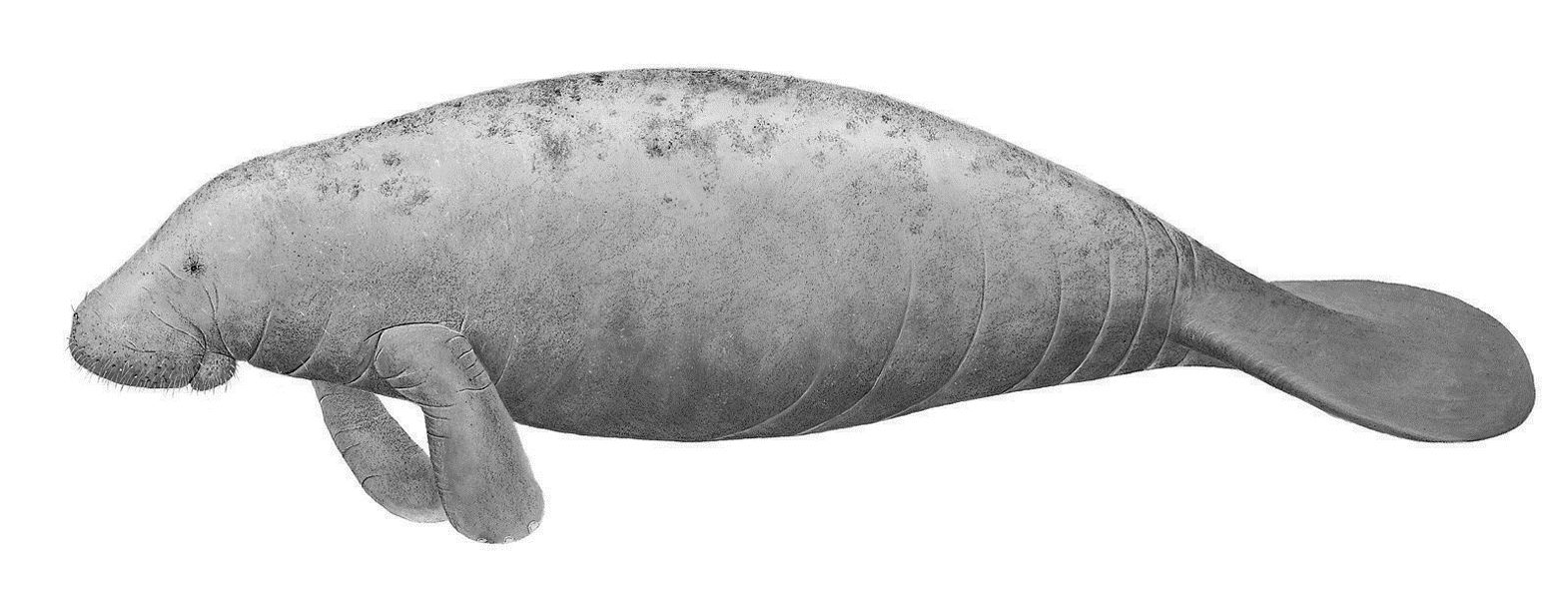WEST INDIAN MANATEE
Trichechus manatus Linnaeus 1758
Order Sirenia : Family Trichechidae
DESCRIPTION. A large, grayish, nearly hairless, aquatic mammal without hind limbs; tail broadened into a horizontal, rounded paddle; front limbs paddle-like. Dental formula: I 2/2 (nonfunctional), C 0/0, Pm 0/0, M 6/6 (variable and continuously being replaced) × 2 = 32. Total length of adults, 2.5–4.6 m; weight typically 200–600 kg, up to a record of 1,650 kg.

DISTRIBUTION. West Indian manatees are found in rivers, estuaries, and coastal areas of the tropical and subtropical New World from the southeastern coast of the United States along Central America and the West Indies to the northern coastline of South America. Manatees are exceedingly rare in Texas waters, although near the turn of the twentieth century they apparently were sighted in the Laguna Madre. Texas records also include specimens from Cow Bayou, near Sabine Lake, Copano Bay, San Jose Island, the Bolivar Peninsula, and the mouth of the Rio Grande.
SUBSPECIES. Trichechus m. manatus.
HABITS. These animals primarily occur in the larger rivers and brackish bays. They are able to live in saltwaters of the sea, however, and travel from one island to another or from place to place along the coast. They are extremely sensitive to cold and may be killed by a sudden drop in the temperature of the water to as low as 8°C. This intolerance doubtless limits their northward distribution in North America. Their irregular occurrence along the Texas coast suggests that they do considerable wandering. Records from Texas probably represent migrants from coastal Mexico or Florida waters.
Sluggish and easily captured, West Indian manatees were once extensively exploited as a food source. Although now protected, manatees still face occasional losses from poaching and from collisions with speedboats. Additionally, habitat loss to land development and channelization continues to pose problems for them. Conversely, in Florida the construction of power plants and industrial parks has apparently been beneficial in creating new warm-water habitat that may be preferred by manatees in winter.
Manatees are opportunistic aquatic herbivores that feed exclusively on aquatic vegetation, although captive animals have eaten lawn grass, dandelions, palmetto, and garden vegetables. Wild manatees seem to prefer submergent vegetation, followed by floating and emergent species. Manatees consume 30–50 kg of food per day. In saline waters, they feed on sea grasses.
Manatees occur in loosely knit groups but are not gregarious by nature. Breeding and calving occurs year round, with the gestation period lasting 12–13 months. Newborn manatees are about 1 m long at birth and weigh 18–27 kg. One young is born per year.
POPULATION STATUS. Extralimital. Excluding the Florida coast, manatees historically have been rare in the Gulf of Mexico, including Texas. A manatee was rescued from the waters of the Laguna Madre near Corpus Christi in 2007, but it was likely a stray from either Florida or Mexican waters to the south. On 24 November 2014 the Marine Mammal Stranding Network in Galveston reported finding a live male manatee in Trinity Bay, Chambers County. Because of the markings on its back, they were able to identify the animal as coming from Tampa, Florida. The manatee was underweight and showed signs of cold stress when removed from the water. Shortly after recovery, the animal was returned to Florida waters.
CONSERVATION STATUS. The USFWS lists the manatee as endangered, and the IUCN status of the West Indian manatee is listed as "vulnerable C1." Populations exist along the Florida coast, but it is unlikely they will ever become reestablished in Texas. Although TPWD lists the manatee as endangered, Texas waters are too cold in the winter to support resident manatee populations.
From The Mammals of Texas, Seventh Edition by David J. Schmidly and Robert D. Bradley, copyright © 1994, 2004, 2016. Courtesy of the University of Texas Press.
Natural Science Research Laboratory
-
Address
Museum of Texas Tech University, 3301 4th street, Lubbock, TX 79409 -
Phone
806.742.2486 -
Email
nsrl.museum@ttu.edu

